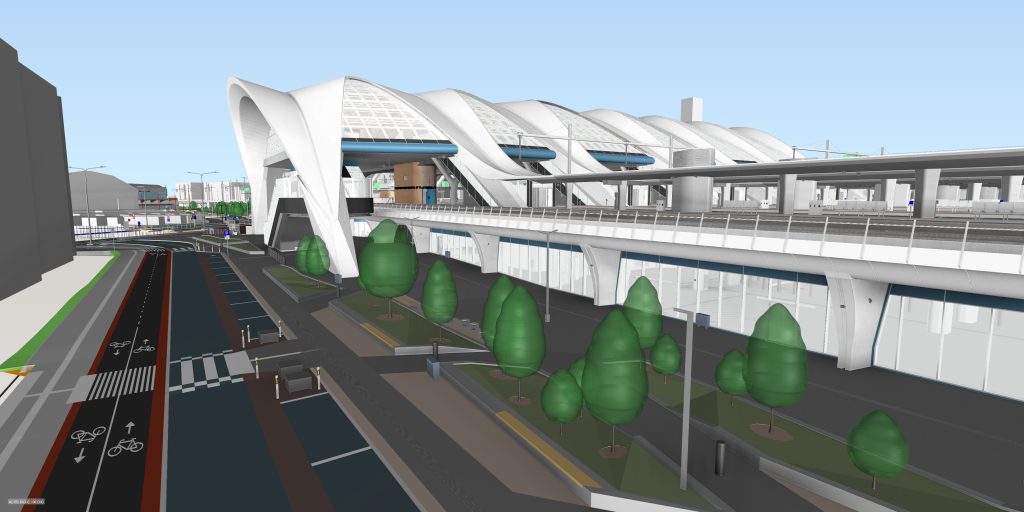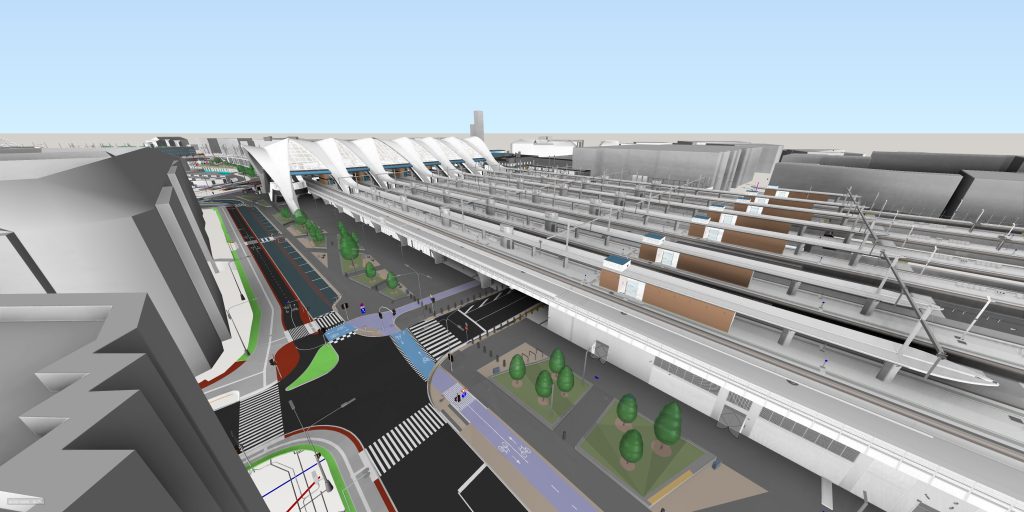In central Riga, Rail Baltica construction works are increasingly visible. Within the territory of Riga International Bus Station, the structure of the railway viaduct is clearly taking shape. Meanwhile, next to the city canal, the walls supporting the Rail Baltica railway bridge over the canal have been fully built, the southern section of the existing railway overpass on the Gogoļa Street has been dismantled, and pile drilling works for the new overpass are continuing. In turn, in one of the most extensive and complicated sections of the project in the Central Station zone the future location of the station’s top floor with waiting premises can already be seen.
 It will serve for 100 years
It will serve for 100 years
Even considering the significant loads that can be generated by railway traffic, the durability specification for Rail Baltica Riga Central Railway Station’s reinforced concrete structures and the building’s foundation solutions envisions that their lifecycle will ensure the building’s service for at least a century. During the station’s design stage special attention was paid to sustainable solutions, including, for example, efficient thermal insulation in order to reduce heating costs and environmental impact, along with other energy efficient technologies. Likewise, construction materials have been carefully chosen, giving precedence to products from highly rated material producers within the construction industry.

For example, for the supply of metal structures, a cooperation agreement has been concluded with the world’s biggest manufacturers, while a class of concrete especially resistant to atmospheric impact has been chosen for concreting works. Mostly, local materials with shorter delivery distances are ordered for the needs of the project.
Likewise, respecting the additions and changes made to the design guidelines, the volume of works of the builder BERERIX has been augmented with explosion-proof and barrier design and construction works, in order that the station can withstand the threats posted by terrorism. Regarding aspects of safety and risk reduction, it should be noted that similarly the building’s ventilation systems will be fitted with hazardous chemical and biological substance detectors and filters.
“Riga Central Station acquired its current form 60 years ago, which was appropriate and modern at that time, but now Riga residents and city visitors will benefit from a completely different level of infrastructure and service quality, along with compatibility with other types of transport and environmental accessibility. In terms of visitor numbers, Rail Baltica Riga Central Station will become the biggest passenger service hub in the Baltics – offering passengers the chance to travel to any destination in Latvia and Europe,” predicts Eiropas Dzelzceļa līnijas Chairman of the Board Kaspars Vingris.

The technologies used and current works
Both the design and construction works of Rail Baltica Riga Central Railway Station area are carried out by integrating technologies and tests highly in the construction industry.
Some time ago, engineers from Canada conducted wind tunnel and comfort tests on a layout of Riga Central Station and surrounding quarters in up to 24 different wind directions, in order to evaluate how durable the station’s structures would be and how comfortable people would feel on the platforms. Similarly, upon commencing construction works, UXO or unexploded munitions (as a legacy of military operations) tests were conducted in the project zone, including Daugava riverbed in order to assess whether there were any unexploded munitions left over as a result of past warfare.

The digital twin has been developed for future infrastructure and station building of Rail Baltica Riga Central Hub–the project is fully coordinated in its full scope using BIM (Building Information Modelling) technologies, where where in a virtual environment, it is possible to see at various levels what is happening and what will happen in the construction site in the near future.
Rail Baltica project is the first in Latvia to use BIM to such a considerable extent and in such detail, which is one of the ways we are increasing the skills, productivity, and competitiveness of companies in our construction industry both locally and internationally.

It should be noted that until now, specialized calculations and simulations regarding the modelling of fire and explosion safety loads have not been necessary for construction needs in Latvia. Also, one of the structural solutions, which most likely is being used in Latvia for the first time is the construction of a railway overpass within the building’s structures as will be the case in this station.
“We are currently proceeding on schedule, and various structures are increasingly visible above ground in the vicinity of Rail Baltica Riga Central Railway Station. The two most visible results of the work so far within this work zone are the construction of the foundation columns of Rail Baltica railway overpass, where 44 of the total of 50 planned columns in the area of the multimodal transport hub have been built, along with the lift and stairwell shafts visible to the residents from the side of Gogoļa Street. They currently reach up to the floor level of the waiting hall on the top floor of the station building. In the central station zone, many different significant processes are taking place concurrently, including the construction of the outer walls that will connect the station to the multimodal transport hub. And we have just begun another important stage – the assembly of the first railway overpass test beams, of which there will be a total of almost 500 on the southern side of the station. We are moving forward, respecting the basic task – to implement the project in a sustainable and high-quality manner,” explains Andis Linde, Stakeholder Manager at BERERIX.

The new station’s most notable characteristics: accessibility, convenience and functionality
Environmental accessibility will be ensured for all public groups at the new Rail Baltica Riga Central Railway Station and in the area surrounding it, along with various conveniences for residents of Riga and city visitor:
- 21 escalators, 12 lifts and 25 new sets of stairs for accessing platforms;
- 8 platforms, 14 railway tracks and heightened platforms for convenient boarding;
- waiting rooms with an area of approximately 6000-6500 m2 (with ticket offices, information board, various services);
- entering the station from all its sides;
- tactile networking throughout the project area from Lāčplēša Street to Jelgava Street and in the station building (tactile guidelines from public transport stops to train platforms);
- intuitive and thoughtful solutions for organizing the flow of people in the station building;
- a new “kiss&ride” street for safe pick-up and drop-off of passengers;
- convenient pedestrian and bicycle connections with Riga International Bus Station and other transport hubs;
- functionality of baggage handling and check-in for flights for trains going to Baltic airports (Riga, Tallinn, Kaunas, Vilnius);
- micromobility opportunities: a new wide bicycle path, opportunities to leave your bicycle, rent a scooter, etc.

Public transport hub – multimodal transport zone
It is planned that the station complex will also include a multimodal transport hub. This means that Elizabetes Street will be connected to Timoteja Street. Beneath the resultant embankment, urban and public transport planner plan to build a major transport hub for inter-city and city transport.
The construction site for the multimodal transport hub spans an area of over 1 hectare. Construction company BERERIXis responsible also for the design of public spacesIn the near future, constructions works will be carried out to build load-bearing structures including surfaces, columns, sidewalks and the road surface. Subsequently, the built zone will be handed over to the responsible parties in order to adapt this space to various types of public transport vehicles and functions.

Construction of Rail Baltica Riga Central Hub is being carried out by the joint venture BERERIX – Belgian construction giant BESIX Group, the national construction company RERE Būve and the Italian construction company Rizzani de Eccher. Concurrently, the works are being done with the involvement of over 200 contractors including foreign specialists and a large number of colleagues from the Latvian construction sector. The work are being carried out in close collaboration with the client – Rail Baltica national implementing body in Latvia Eiropas Dzelzceļa līnijas, while construction is financed by the state and the European Union.
*The article was created in cooperation with Delfi.lv
